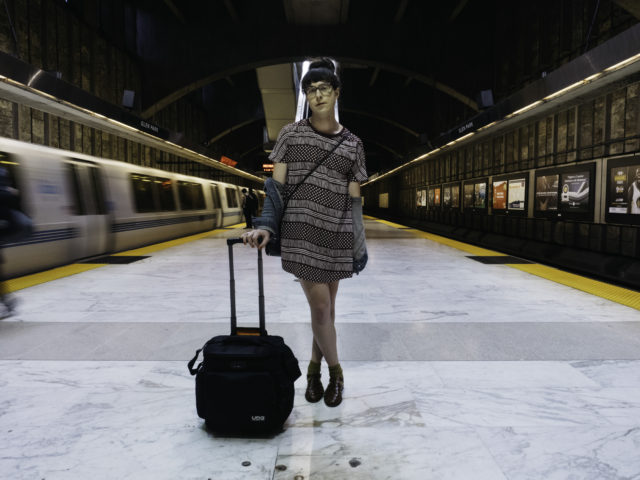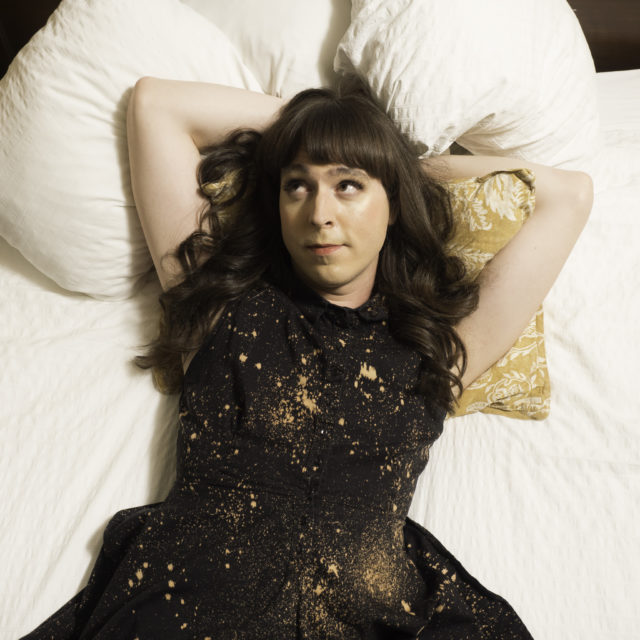The last few months, let alone the last year, have been incredibly compounded with waves of emotionalism, growth, and a flux of releases for DJ Octo Octa (née Maya Bouldry-Morrison). The Brooklyn-based electronic artist came out as transgender in 2016, and through a very public article on Resident Advisor that addressed her transition, Bouldry-Morrison’s career burgeoned. More than ever, she feels comfortable in queer spaces and is connecting with international communities in the electronic music sphere.
Moreover, in the past few months, her collaboration project, Frendzone’s, joint EP, the album “Where Are We Going?” and the 12” “New Paths” through Chicago-based label Argot were all released within the last few months. Bouldry-Morrison’s crispy and lush house tracks are much like her personality. Her veracity and playfulness mirror the narrative process found in the synths and kick drums in her work; as infectious as her laugh.

Bouldry-Morrison started dabbling with electronic music while living in New Hampshire when she was a teenager. In the beginning, she played around with intelligent dance music (IDM) and Breakcore and in 2011, started to experiment with house. Her meticulous sonic perspective paired with her understanding of sentiment landed her on the 50 Best Dance Songs of 2014 in SPIN Magazine.
“I started understanding house music and a 4/4 beat,” Bouldry-Morrison says. “Before, I was like ‘This is too boring. It’s too repetitive. There’s not enough things changing.’ After getting people to dance more, I started to do that type of music instead. I quickly played out the first song I made that was on my first release. I played it at a party and got a great reaction. I love dancing. It’s really important to me. It just took me nine years to figure out how to get people dancing.”
Beginnings were difficult and slow for Bouldry-Morrison, as they are for most creative paths. As a young artist, contacting labels was difficult, as social media access was absent and labels weren’t accepting demos. However, she built a correspondence with one: 100% Silk.
“That really set things off for me,” Bouldry-Morrison says. I got my first tour. I started playing in clubs. Since that time, it’s been a very slow and steady build up. I slowly got shows. I did a feature in Resident Advisor where I came out publicly as trans. From there, I got a ton of more bookings. So things are going up again. Now I’m doing more stuff than ever. I’m playing a lot. It’s weird because it went away once so I’m always expecting for it to go away again. It’s wonderful that it’s happening right now though.”
Instead, it’s like, here’s an enormous
transmission of my transition.
As someone whose career exists in a public sphere, Bouldry-Morrison had to make the choice of coming out privately to her friends and family, and then directly communicating to the public, which she did with her piece in Resident Advisor.
“Why not do a really nice feature instead of me writing a really quick note on Facebook and still having to come out to people when I arrived at clubs?” Bouldry-Morrison says. “It was helpful. It was strange. But I’m happy that I did it than having to come out to people all of the time individually. Instead, it’s like, here’s an enormous transmission of my transition. Here’s an info dump, enjoy it.”
As for how and where she works, Bouldry-Morrison keeps it simple. She’s straightforward with her answers. There aren’t any fabrications — she doesn’t gush about her hardware or her record collection. She walks me through her studio via Skype. “How much of a mess is it right now? Can you see how bad it is?” she asks. “Before I had a studio, people would be like ‘Hey, can we take a picture of you in your studio working?’ And I would be like, ‘Do you want to sit at the kitchen table with me while I sit on my laptop with some headphones?’”
She points towards a couch in her apartment. “I mostly sit with my laptop, watch TV, drink coffee, and when I get bored of watching TV, I pause it for a second and I open up Ableton Live,” Bouldry-Morrison says. “I start making something and I’m like, ‘That sounds cute.’ Sometimes, it’ll be two hours of working on something or sometimes it’ll be fifteen minutes and I’m like ‘Hmmm, I’m gonna watch some more TV.’”

The process, for an artist whose work is so incredibly personal and pivotal to the queer community, is comforting with this description of its transparent production. Maya admits that she gets brutal writers block. Unlike other producers, she doesn’t work under a set schedule. She mostly works off of a “tingle.”
“All the sound stuff I do is based on feeling,” Bouldry-Morrison explains. My brain latches on to this one thing that I seem to keep doing over and over and over again. I’m not thinking about what’s happening. I play around for a little bit. Inevitably, some feeling or tone will come out of it.”
This isn’t to say that Bouldry-Morrison’s work is simple in the sense that it’s lacking depth. Her debut album in 2013, “Between Two Selves” and her 2017 release, “Where Are We Going?” clearly distinguish the moments before coming out and the moments after, the rush of feelings felt before a public transformation and the aftermath — the dewy beginning.
“I like all of the music I have to have an emotional core to it,” she says. “I find that the music that doesn’t have some tie to my life — it may sound good, as a club track — but there is nothing interesting beyond that. I’m not a huge fan of music that’s not trying to say something. That’s why I like House music and that’s why I DJ a lot of vocal House.”
Before Bouldry-Morrison came out publicly, she released, “Between Two Selves,” originally set to be called, “Trans.” The album signifies the transitional phase in her life. “I really like emotion and lyrics,” she says. “Something that is beyond a kick drum. Everything that I do, I like it to be tied to my life in some way. I like doing that through track titles and some lyrical content, as little as it may be.”
It’s a “coded queer message” but it also deals with overwhelming uncertainty. Tracks like “Please Don’t Leave” resemble Bouldry-Morrison’s anxiety over her wife leaving her. Although fully supportive of the transition, her lingering concerns present vulnerability. Her decision to come out to her family didn’t occur until 2016, when she began working on her second album “Where Are We Going?”

I appreciate queer spaces a lot. It’s a space
that I get to move through and I don’t
second guess myself.
The album on Honey Soundsystem HNYTRX, a queer San Francisco DJ crew and record label, is the first that the label has released by a contemporary artist. The collaborative efforts with Jacob Sperber (aka Jackie House) is a beneficial relationship for Bouldery-Morrison’s creative practice. “It’s super nice,” she says. “Jackie puts a ton of attention into detail.”
“Where Are We Going?” is a vehicle that serves as a transcription for Bouldry-Morrison’s future after her transition. “This is my art,” she tells me. “This is how I express myself. I would rather express myself with things that have an emotional core than banger club tracks. Those are fun! But I’ll let someone else make those.”
Tracks like, “No More Pain (Promises to a Younger Self)” feature lambent emotion through R&B vocal loops and drum breaks. The entirety of the album is warm and textural. Fading out of the first track, “Where Are We Going Part I,” Bouldry-Morrison sampled a conversation between her and a friend staring up at the stars at Montauk. “He’s just being a goof, like he normally is,” she says. “He’s like, ‘What do you think the meaning of life is?’ I try to have this cute, positive outlook on life in the beginning but still end it with tracks like ‘Adrift’ that’s a drone techno track of feeling super weird about not knowing what’s going on right now.”
The release occurred pre-Trump and the album title still signifies the uncertainty of what the future holds for queer people in the United States. What comes with transitioning are Maya’s recollections of harassment as a publicly queer and trans person. Navigating through the world has always been difficult, but she says that now, it’s even more “weird.”
Concluding “Where Are We Going?” is the track titled, “Where Are We Going Part II,” which samples Bouldry-Morrison’s voice repeatably saying, “Do you feel better?”’
“Yeah, I feel better,” she says. “It’s a really interesting question in that it feels like it’s a question that shouldn’t need to be asked. Of course I feel better now. I made this big life choice. I know that when people would ask me that, it’s not their intention. They are just checking in. Yes, I feel better but I interact with the world in a much different way than I did forever ago. You know, I don’t take the subway anymore. I hate dealing with people on the subway. You get people taking pictures of you, people staring at you. New things are happening that I have to learn how to deal with. It’s just weird. I feel better, things are really good, but the world is a lot weirder to deal with now.”
She tells me about the accepting spaces in the city and the happiness she feels now that she’s playing in venues that identify as safe spaces. “I appreciate queer spaces a lot. It’s a space that I get to move through and I don’t second guess myself,” she says.
Bouldry-Morrison has a plan to move to New Hampshire scheduled for the future — a music video in production, and upcoming tour dates, her strong relationship with her wife is a constant. The couple have been together since they were 14 and both consider themselves queer.
In 2017, Bouldry-Morrison’s career seems to be stabilized, concrete, tactile. Her releases since 2015 sound more refined. Her earlier work was more concentrated on sampled vocals, while her newer work is more consistent, more instrumental. “I’ve gotten better at having better mix downs for tracks so they aren’t as muddy or gross as tracks that I’ve made six years ago,” she says. “I’ve been slowly getting technically better.”
The DJ isn’t decelerating anytime soon — and her energy isn’t being ignored. Alongside her DJ partner Kellam Matthews, Bouldry-Morrison hosts a monthly party at the Bossa Nova Civic Club called Frendzone. The similarly named record label released a split album with German based producer Ames Henry on Side B. Additionally, a 360 virtual reality music and art installation video for “Adrift” is in the works with artist Ray McClure.” She’s currently scheduled to play Together Festival, Moogfest, and Movement for the month of May.
When asked where she sees herself in the future, she laughs and says, “I’m just trying to pay a goddamn bill.”

What Do You Think?